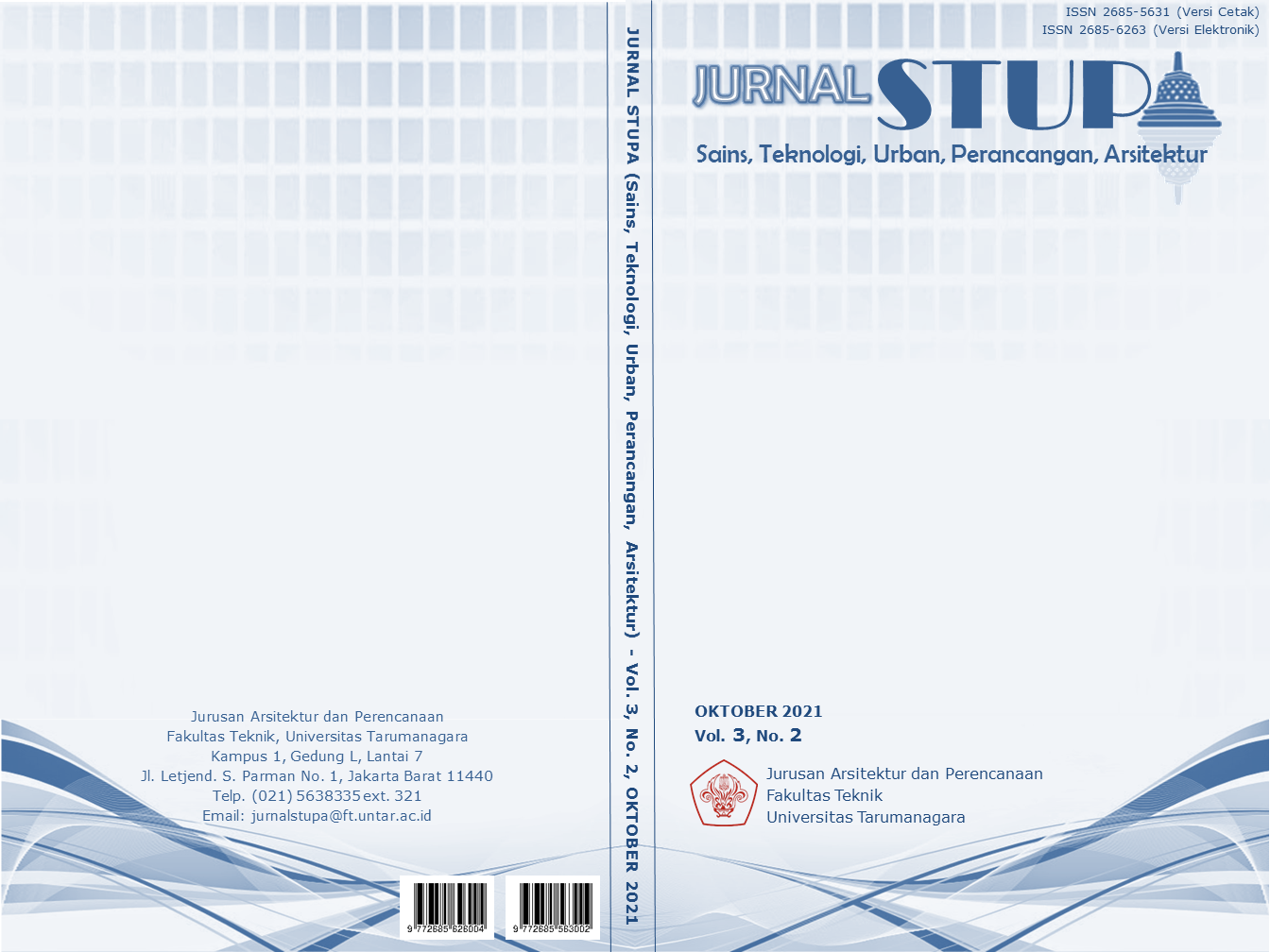PENDEKATAN KARAKTERISTIK TANAMAN DALAM PERANCANGAN ARBORETUM
Main Article Content
Abstract
Indonesia is rich in various types of diverse flora. However, due to the fact that most of the land that becomes the media and source of livelihood for plants is decreasing due to the interests of humans to build buildings, it threatens the sustainability of plants, especially in big cities and their surroundings (Fabian and Malte 2011). Even though the existence of vegetation has an important role in the balance of nature in its environment. So that damage or loss of a number of vegetation varieties is a threat to organisms in the environment. In today shows that the plant varieties already experiencing scarcity of rare status with low risk (least concern) to extinction (extinct) (IUCN). Conservation efforts are needed for the existence of flora varieties with conservation. Ex-situ conservation facilities in urban areas for plant conservation include preservation, protection, and controlled use resulting in new ecosystems. Botanical preservation also requires awareness from a human point of view. Humans are creatures that have the most influence on natural life. Everyday humans interact with the natural environment, one of which is with plants. From this interaction, humans can have a negative or positive impact on the plant environment. Which means, as a part that has an impact on the plant environment, humans have an important role in determining attitudes to preserve plants according to their capacity in life. By stimulating and understanding the preservation of plants, humans take part in a role that has a big influence on the preservation of botany.
Keywords: Arboretum; Botany; Edutainment; Conservation
Abstrak
Indonesia kaya akan berbagai jenis flora yang beraneka ragam. Tetapi akibat sebagian besar lahan yang menjadi media dan sumber penghidupan tumbuhan semakin sedikit akibat kepentingan manusia membangun bangunan, sehingga mengancam kelestarian tumbuhan terutama di kota besar dan sekitarnya (Fabian dan Malte 2011). Padahal eksistensi vegetasi memiliki peran penting dalam keseimbangan alam di lingkungannya. Sehingga rusak atau hilangnya sejumlah varietas vegetasi merupakan ancaman bagi organisme di lingkungannya. Di jaman sekarang terlihat bahwa varietas tumbuhan sudah mengalami status kelangkaan dari langka dengan resiko rendah (least concern) sampai punah (extinct) (IUCN). Diperlukannya upaya pelestarian terhadap eksistensi varietas flora dengan adanya konservasi. Fasilitas pelestarian tanaman secara ex-situ mencakup perawatan, perlindungan, dan pemanfaatan yang terkontrol sehingga terjadi ekosistem baru. Pelestarian botani juga membutuhkan kesadaran dari segi manusia. Manusia merupakan makhluk yang paling berpengaruh terhadap kehidupan alam. Sehari-harinya manusia berinteraksi dengan lingkungan alam, salah satunya dengan tumbuhan. Dari interaksi tersebut, manusia dapat memberikan dampak negatif maupun positif terhadap lingkungan tumbuhan. Yang artinya, sebagai bagian yang memiliki dampak terhadap lingkungan tumbuhan, manusia memiliki peranan penting dalam menentukan sikap untuk melestarikan tumbuhan sesuai kapasitasnya di kehidupan. Dengan stimulasi dan pemahaman mengenai pelestarian tumbuhan, manusia ikut mengambil peran yang memberikan pengaruh besar terhadap kelestarian botani.
Article Details
References
Collins, N. M., Sayer, J. A. & Whitmore, T. C. (ed.), (1991). The Conservation Atlas of Tropical Forest Asia and the Pacific. MacMillan Press, London.
Mielcarek, L. (2000). Factors Associated with the Development and Implementation of Master Plans for Botanical Gardens. Arizona: The University of Arizona
Botanic Gardens Conservation International (BGCI). (2012). The Role of Botanic Gardens in Plant Conservation. Kew, United Kingdom.
Dahlan, E. N. (1992). Hutan Kota : Untuk Pengelolaan dan Peningkatan Kualitas Lingkungan Hidup. Jakarta: Asosiasi Pengusaha Hutan Indonesia (APHI)
Edward O. Guerrant Jr., Kayri Havens, & Mike Maunder. (2004). Ex Situ Plant Conversation : Supporting Species Survival in the Wild. Washington DC: Island Press.
Fromme, T. (2006). Designing Great Gardens : Defying Classification and Seeking Relevance. Public Garden, 24-27.
Houston, C. (2009). Conservation Design Guidelines for Botanic Gardens. Utah: Utah State University.
Wyse-Jackson, P. S. and Sutherland, L. A. (2000). International Agenda for Botanic Gardens in Conservation. Botanic Gardens Conservation International, U. K.
Portico Group, T. (1997). Master plan for tthe San Luis Obispo botanical garden. Seattle: The Portico Group
Fakhrozi, I., Hikmat, A., & Widyatmoko, D. (2013). Konservasi ex situ Mangifera casturi Kosterm berbasis masyarakat: studi kasus di Kabupaten Indragiri Hilir, Provinsi Riau. Jurnal Biologi Indonesia 9 (1): 141-151
Fromme, T. (2006). Designing Great Gardens : Defying Classification and Seeking Relevance. Public Garden, 24-27.



